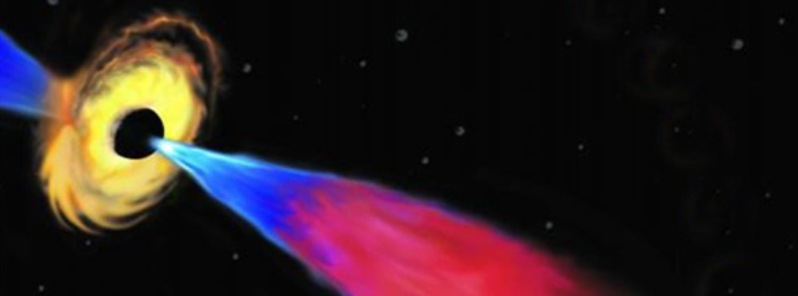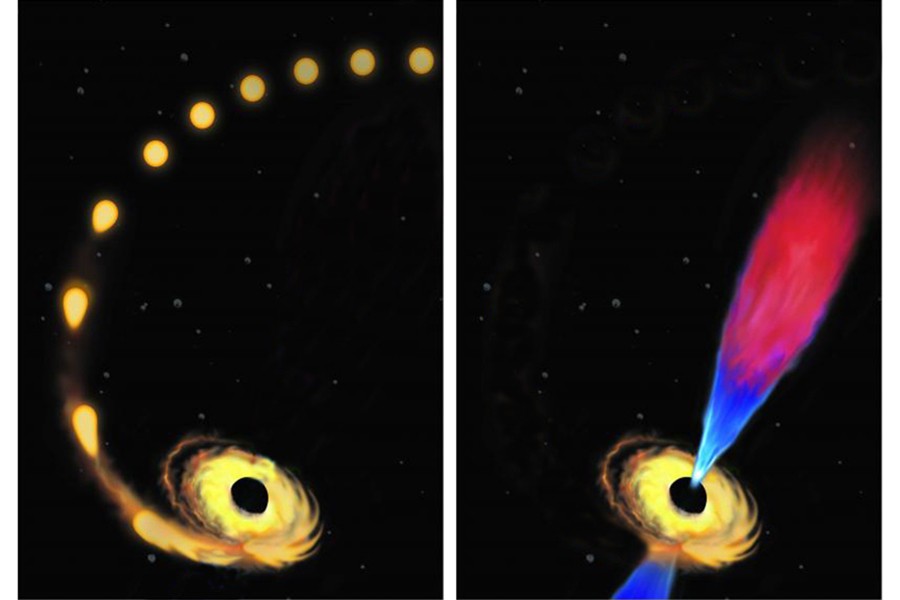Scientists get unique chance to study black hole eating a star

A team of astrophysics led by a Johns Hopkins University (JHU) scientist has for the first time witnessed a black hole swallowing a star and ejecting a flare of matter moving nearly the speed of light (about 300,000 km/s).
The finding tracks the star, which is about the size of our sun, as it shifts from its customary path, slips into gravitational pull of a supermassive black hole and is sucked in, said Sjoert van Velzen, a Hubble fellow at Johns Hopkins. "These events are extremely rare," van Velzen said. "It's the first time we see everything from the stellar destruction followed by the launch of ca conical outflow, also called a jet, and we watched it unfold over several months."
Black holes are ares of space so dense that irresistible gravitational force stops the escape of matter, gas and even light, rendering them invisible and creating the effect of a void in the fabric of space. Astrophysics had predicted that when a black hole is force-fed a large amount of gas, in this case a whole star, then a fast-moving jet of plasma, elementary particles in a magnetic field, can escape from near the black hole rim, or "event horizon".
The study suggests this prediction was correct, the scientists said. "Previous efforts to find evidence for these jets, including my own, were late to the game," said van Velzen, who led the analysis and coordinated the efforts of 13 other scientists in the United States, Great Britan and Australia. Supermassive black holes, the largest of black holes, are believed to exist at the center of most massive galaxies. This particular one lies at the lighter end of the supermassive black hole spectrum, at only about a million times the mass of our sun (Sun's mass is about 1.989*1030 kg), but still packing the force to gobble a star.

Artist’s conception of a star being drawn toward a black hole and destroyed (left), and the black hole later emitting a “jet” of plasma composed of the debris left from the star’s destruction. Modified from an original image by Amadeo Bachar.
The first observation of the begining of the destruction was made by a team at the Ohio State University (OHU), using an optical telescope in Hawaii. That team announced its discovery on Twitter in early December 2014. After reading about the event, van Valzen contacted an astrophysics group team led by Rob Fender at the University of Oxford in Great Britain. That group used radio telescopes to follow up as fast as possible and they were just in time to catch the action.
By the time it was done, the international team had data from satellites and ground-based telescopes that gathered X-ray, radio and optical signals, providing a stunning "multi-wavelength" portrait of this event. It helped that the galaxy is question is closer to Earth that those studied previously in hopes of tracking a jet emerging after the destruction of a star. This galaxy is about 300 million light years away, while the others were at least three times farther away. One light year is 5.88 trillion miles or 9.46 trillion kilometers.
The first step for the team was to rule out the possibility that the light was from a pre-exisiting expansive swirling mass called an "accretion disk" that forms when a black hole is sucking in matter from space. That helped to confirm that the sudden increase of light from the galaxy was due to newly trapped star. "The destruction of a star by a black hole is beautifully complicated, and far from understood," van Velzen said. "From our observations, we learn that the streams of stellar debris can organize and make jet rather quickly, which is valuable input for constructing a complete theory of the events."
Reference:
- "A radio jet from the optical and X-ray bright stellar tidal disruption flare ASASSN-14li" – S. van Velzen, G. E. Anderson, N. C. Stone, M. Fraser, T. Wevers, B. D. Metzger, P. G. Jonker, A. J. van der Horst, T. D. Staley, A. J. Mendez, J. C. A. Miller-Jones, S. T. Hodgkin, H. C. Campbell, R. P. Fender – Science Express – November 26, 2015 – DOI: 10.1126/science.aad1182
Featuring image: Artist's conception of a star being drawn toward a black hole and destroyed (left) and black hole emitting a "jet" of plasma composed of the debris left from star's destruction. Image credit: Amadeo Bachar (modification from the original image)

Commenting rules and guidelines
We value the thoughts and opinions of our readers and welcome healthy discussions on our website. In order to maintain a respectful and positive community, we ask that all commenters follow these rules:
We reserve the right to remove any comments that violate these rules. By commenting on our website, you agree to abide by these guidelines. Thank you for helping to create a positive and welcoming environment for all.